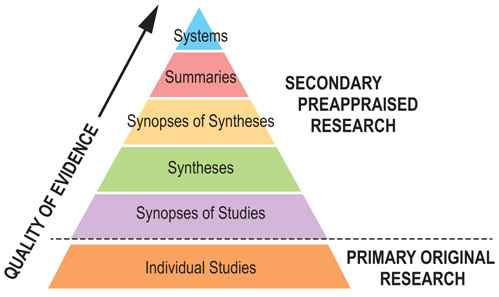Levels of evidence
One approach to help the busy clinician find the best evidence quickly has been suggested by Brian Haynes. It's a hierarchical approach with 6 levels of evidence. Primary and secondary evidence is often ranked into levels according to the quality of research studies when it is used to make evidence-based clinical decisions. This is often known as the evidence ‘hierarchy’, and is illustrated in the pyramid below. Levels of evidence are generally used in clinical practice guidelines and recommendations to allow clinicians to examine the strength of the evidence for a particular course of treatment or action.
The levels are in descending order of usefulness to busy clinicians. The idea is to start at the top and work your way down until you find an answer to your clinical problem, with the primary or original research at the base of the pyramid. If every other ‘S’ level fails to provide an answer to your question it is time to look for original studies. These include randomised controlled trials, cohort studies, case control studies, and cross sectional studies.

Read the following paper which describes the 6 level evidence pyramid: the “6S” model of evidence. [14]
